From Day 13 to Fledging
ATTENTION: If you have an older Tree Swallow nestling or nestlings whose development is not proceeding well and that you believe is in trouble and needs human intervention in order to survive, here’s a procedure for Temporary Care of Nestling Tree Swallows .
At Your Boxes:
Older Tree Swallow nestling development continues at an amazing rate. By day 12 or 13 many actually outweigh their parents! Their body contour feathers are maturing, and their flight feathers are rapidly lengthening, though they are still significantly shorter than those of adults. And by day 16 their skeletons are nearing adult size. Your nestlings are starting to look like proper Tree Swallows and their behavior shows they will fledge soon.
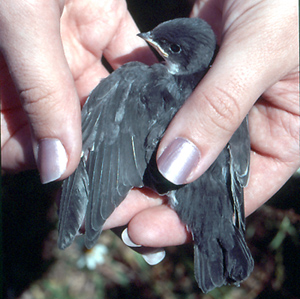
Warning! Do NOT check any boxes where nestlings are over 12 days! Don’t go anywhere near them if you can avoid it. Observe boxes from a distance because, if startled, older nestlings may leap out of the box and try to fly before their flight feathers and muscles are ready. If you return them to the box they usually jump back out again. Nestlings that try to fledge prematurely in this way usually die. (The picture above of a 15 day nestling was taken before we understood the dangers involved in handling nestlings this old).
This means NO banding nestlings over 12 days old! See Banding Nestling Tree Swallows for more on this subject.
Note: If you don’t know the age in days of the young at your Tree Swallow project, you can make a close estimate by observing their flight feather development. Look at the 12 day nestling’s wing, below. Notice how the flight feathers have partly erupted from their sheaths, so they look like little paintbrushes. If you find that nestlings in a box have flight feathers more erupted than these, leave them alone! Handling them for any reason, even banding, risks premature fledging and the death of the young birds.
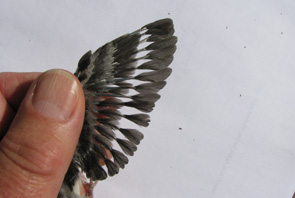
Concepts:
How has begging changed as nestlings have grown?
- A nestling’s begging calls can vary, depending on its size and stage of development, how hungry or warm it is, and how many nestmates it is competing with for food.
- Shortly after hatching nestlings began to give weak, high-pitched peeps.
- By week two begging calls have become two or three syllable, louder, harsher, and lower-pitched.
- As fledging nears in week three, begging nestlings give rapid, loud chattering notes, repeated often.
- As nestlings age their individual begging calls become more like those of their own nestmates, and less like begging calls of broods in other nests.
- It’s possible these call differences among broods will help parents identify their own young for continued feeding after they have left the nest.
How has adults’ feeding of young changed?
- By the end of two weeks nestlings often clamber up to and perch in cavity entrances, as in the photo below by Liam Gerety.
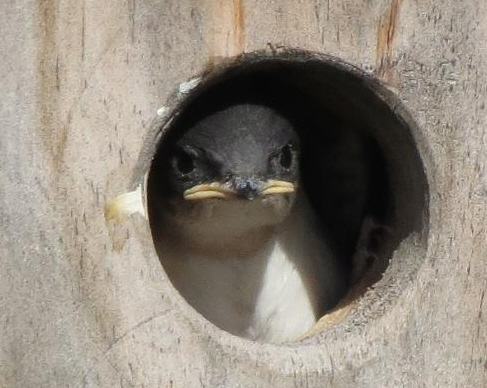
- Since access to the interior of the box is frequently blocked now by waiting nestlings, adults may simply land briefly at the hole and tip their heads and upper bodies in and transfer food without fully entering the box. Photo below from Francois Paquette. Note that one is receiving food while the other five beg.
- Here’s a YouTube video showing how adult swallows fed 13-16 day old nestlings.
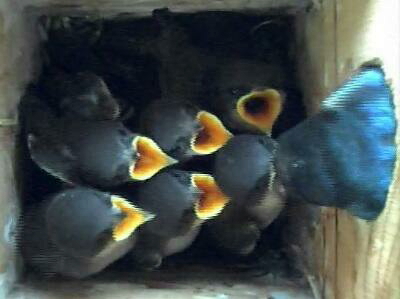
- Still later, as Tree Swallow nestling development nears fledging, they perch at the hole with heads partly out, begging loudly when adults approach. Photo below by Greg Page.
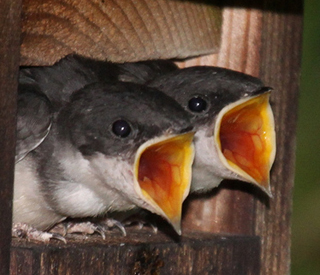
- Food exchange now becomes so rapid it’s hard to see. Adults perch very briefly or flutter in front to make the pass. Photo below by Brett Burleigh.
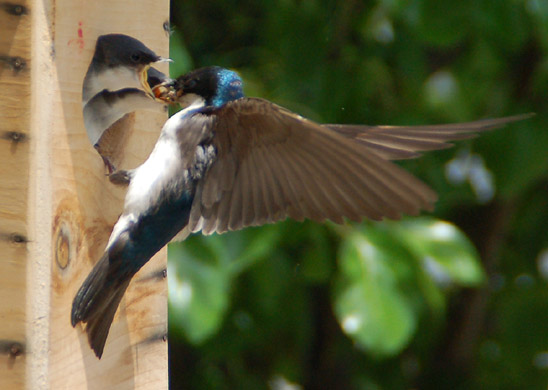
- As fledging days near adults seem to reduce feeding somewhat.
- Adult behavior eventually progresses from entering the box to feed young, to tipping in to feed young, to feeding young at the hole. So watching adults can give you clues to the developmental status of their nestlings.
- Adults with large young have time for little else but foraging for and feeding them.
Do Tree Swallow nestlings compete for food?
- Yes, they do compete with their brothers and sisters. You can see this yourself in this YouTube video of older nestlings jockeying for position.
- On any feeding visit the nestling that is nearest the incoming adult and that begs soonest and most vigorously will usually get the food.
- Nestlings that are temporarily full won’t beg, giving others a chance to be fed.
- If food is scarce, all young are constantly hungry and beg whenever adults arrive. The least effective will starve and die unless the shortage eases.
- Adults won’t feed unresponsive (non-begging) nestlings.
- Stronger late-stage nestlings can monopolize the entrance hole, preventing those inside from reaching food.
- The food exchange technique seen below in Steve Byland’s photo insures one nestling gets everything a parent brings on a given visit.
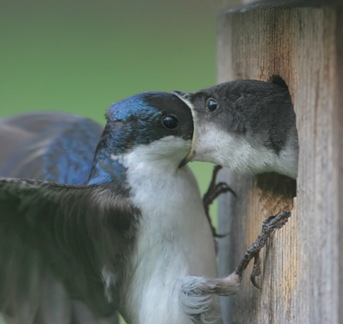
Older nestlings beg very loudly. Could this have negative consequences?
- The racket could draw predators. Perhaps to counter this risk, nestlings 15 days and older will reduce begging calls and crouch down in their nest if parents give alarm calls.
- It has been theorized that begging may manipulate parents to forage harder in order to keep nestlings quiet so predators won’t be attracted.
- It has also been suggested that begging displays take a lot of energy to produce, but research has shown the energetic cost to nestlings is actually quite small.
What other behavior changes do older nestlings show?
- As you would expect older nestlings begin to exhibit adult-like behaviors.
- The chest muscles that will propel flight are maturing rapidly now. From about day 15 on nestlings start exercising their wings, provided there is room inside the cavity. Holding down firmly with their feet they make short bursts of rapid flapping, their wings a blur.
- Here’s a YouTube video from Francois Paquette showing 15 and 16 day old Tree Swallow nestlings fluttering inside a nest box.
- Given sufficient room in a box, by the time they must actually fly from the nest they will have flapped their wings thousands of times. This underscores the importance of providing boxes with spacious, not cramped, interiors.
- By day 15 the nestlings demonstrate body maintenance behaviors typical of adults. These include preening their now quite well-developed feathers, head scratching, and wing stretching.
What are the flecks of white powder on older nestlings and in the boxes?
- Most is waxy feather sheath material that disintegrates as feathers erupt and nestlings preen.
- Some may be dried and pulverized fecal debris.
Do adults still remove fecal sacs from late-stage nests?
- Once older nestlings start blocking entrances, as in the picture below by Bruce Vanderveen, it’s more and more difficult for adults to access box interiors.
- Fecal material now accumulates on the floors and up the sides of boxes as nestlings try to excrete outside the areas where they sit.
- As a result what do you think nests look like now? You’ll see when you open the boxes after you’re certain the young have fledged. It won’t be pretty.
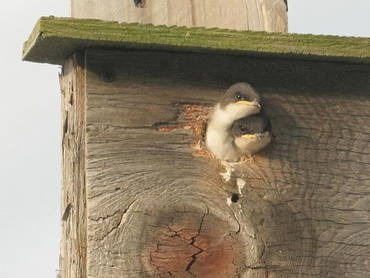
Questions for the next Topic: Tree Swallow Fledging
- What is “fledging?”
- What must Tree Swallow nestlings be able to do when they leave the nest?
- Do you think parent Tree Swallows will care for their young after they fledge? If so, in what way and for how long?
———————————————————————————–
Home: Tree Swallow Nest Box Projects
Creating Tree Swallow Nest Box Projects
Spring Return
Nesting Season Behavior
Song and Calls
Nest Site Claiming
Pair Formation
Nest Building
Bird Flight
Mating and Paternity
Diary of One Season at Salmon Creek
Monitoring Nest Boxes and Keeping Records
Making Box Checks Keeping Box Records Control Sheets Season Summaries Print Sheets
Banding Your Tree Swallows Banding Adults Banding Nestlings
Tree Swallows in Research Research Bibliography Glossary of Terms